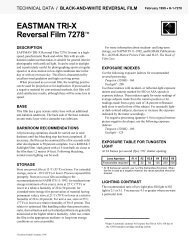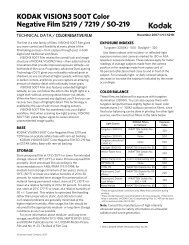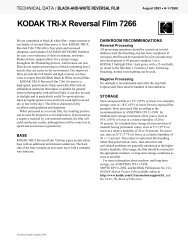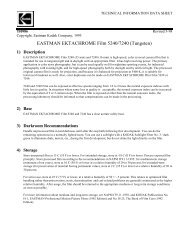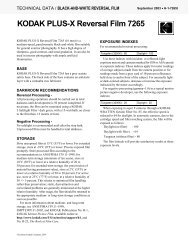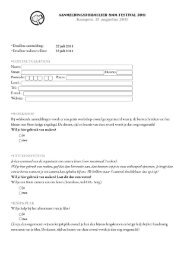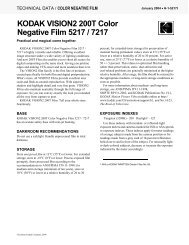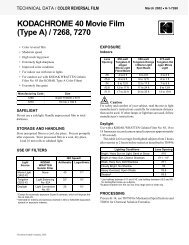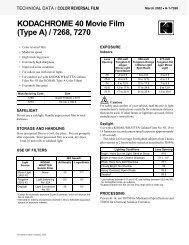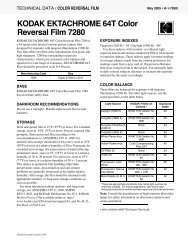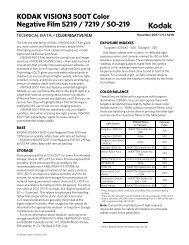KODAK VISION3 200T Color Negative Film 5213 / 7213 / SO-213
KODAK VISION3 200T Color Negative Film 5213 / 7213 / SO-213
KODAK VISION3 200T Color Negative Film 5213 / 7213 / SO-213
Create successful ePaper yourself
Turn your PDF publications into a flip-book with our unique Google optimized e-Paper software.
<strong>KODAK</strong> <strong>VISION3</strong> <strong>200T</strong> <strong>Color</strong><br />
<strong>Negative</strong> <strong>Film</strong> <strong>5<strong>213</strong></strong> / <strong>7<strong>213</strong></strong> / <strong>SO</strong>-<strong>213</strong><br />
TECHNICAL DATA / COLOR NEGATIVE FILM<br />
<strong>KODAK</strong> <strong>VISION3</strong> <strong>200T</strong> <strong>Color</strong> <strong>Negative</strong> <strong>Film</strong> <strong>5<strong>213</strong></strong>/<strong>7<strong>213</strong></strong> is<br />
a 200-speed tungsten film that provides the image<br />
structure of a 100 speed film with the versatility of a 200<br />
speed product—offering you the benefits of two films in<br />
one.<br />
Like other films in the <strong>KODAK</strong> <strong>VISION3</strong> <strong>Film</strong> family,<br />
<strong>VISION3</strong> <strong>200T</strong> <strong>Film</strong> features unrivaled highlight latitude,<br />
reduced grain in shadows, flexibility in post, and, of course,<br />
proven archival stability. Additionally, you’ll find that this<br />
film performs superbly in both controlled interiors and in<br />
challenging high-contrast exteriors.<br />
Experience the improved extreme exposure<br />
performance and consistent <strong>VISION3</strong> <strong>Film</strong> family look.<br />
Enjoy the added flexibility and increased creative control<br />
that comes with all the detail captured in the extremes of<br />
exposure. Benefit from the value in time and money that<br />
can be realized both on set and in postproduction.<br />
BASE<br />
<strong>KODAK</strong> <strong>VISION3</strong> <strong>200T</strong> <strong>Color</strong> <strong>Negative</strong> <strong>Film</strong>s <strong>5<strong>213</strong></strong> and<br />
<strong>7<strong>213</strong></strong> have an acetate safety base with rem-jet backing.<br />
<strong>KODAK</strong> <strong>VISION3</strong> <strong>200T</strong> <strong>Color</strong> <strong>Negative</strong> <strong>Film</strong> <strong>SO</strong>-<strong>213</strong> has<br />
an ESTAR Safety Base with rem-jet backing.<br />
STORAGE<br />
Store unexposed film at 13° C (55° F) or lower. For<br />
extended storage, store at -18° C (0° F) or lower. Process<br />
exposed film promptly. Store processed film according to<br />
these recommendations:<br />
Unexposed film<br />
in original, sealed<br />
package<br />
Exposed film,<br />
unprocessed<br />
Process film<br />
Short Term<br />
(less than 6 months)<br />
13° C (55° F)<br />
RH below 60%<br />
-18 to -23° C<br />
(0 to-10° F)<br />
RH below 20%<br />
21° C (70° F)<br />
RH 20 to 50%<br />
Long Term<br />
(more than 6 months)<br />
-18 to -23° C<br />
(0 to-10° F)<br />
RH below 50%<br />
Not recommended.<br />
Process film promtly.<br />
2° C (36° F)<br />
RH 20 to 30%<br />
This relates to optimized film handling rather than<br />
preservation; static, dust-attraction and curl-related<br />
problems are generally minimized at the higher relative<br />
humidity. After usage, the film should be returned to the<br />
appropriate medium- or long-term storage conditions as<br />
soon as possible.<br />
May 2010 • H-1-<strong>5<strong>213</strong></strong>t<br />
Warm-upTimes<br />
To prevent film telescoping, moisture condensation, and<br />
spotting, allow your film to warm to room temperature<br />
before use:<br />
<strong>Film</strong> Package<br />
For more information about film storage and handling,<br />
see ANSI/PIMA I<strong>SO</strong>-18911, SMPTE RP131-2002, and<br />
<strong>KODAK</strong> Publication No. H-845, The Essential<br />
Reference Guide for <strong>Film</strong>makers, available online at<br />
www.kodak.com/go/referenceguide.<br />
DARKROOM RECOMMENDATIONS<br />
Do not use a safelight. Handle unprocessed film in total<br />
darkness.<br />
EXPOSURE<br />
Exposure Indexes<br />
Tungsten (3200K) - 200<br />
Daylight- 125 (with 85 filter)<br />
Typical Warm-up Time (Hours)<br />
14° C (25° F) Rise 55° C (100° F) Rise<br />
Super 8 1 1 1 /2<br />
16 mm 1 1 1 /2<br />
35 mm 3 5<br />
Use these indexes with incident- or reflected-light<br />
exposure meters and cameras marked for I<strong>SO</strong> or ASA<br />
speeds or exposure indexes. These indexes apply for meter<br />
readings of average subjects made from the camera<br />
position or for readings made from a gray card of<br />
18-percent reflectance held close to and in front of the<br />
subject. For unusually light- or dark-colored subjects,<br />
decrease or increase the exposure indicated by the meter<br />
accordingly.<br />
©Eastman Kodak Company, 2010
<strong>Color</strong> Balance<br />
These films are balanced for exposure with tungsten<br />
illumination (3200K). You can also expose them with<br />
tungsten lamps that have slightly higher or lower color<br />
temperatures (+/- 200K) without correction filters, since<br />
final color balancing can be done in printing.<br />
Light Source<br />
<strong>KODAK</strong> Filters<br />
on Camera *<br />
Exposure<br />
Index<br />
Tungsten (3000 K) None 200<br />
Tungsten (3200 K) None 200<br />
KINO FLO KF29<br />
KINO FLO KF32<br />
Daylight (5500 K)<br />
Metal Halide<br />
HMI<br />
KINO FLO KF55<br />
None 200<br />
WRATTEN 2 Optical<br />
Filter / 85<br />
WRATTEN 2 Optical<br />
Filter / 85<br />
WRATTEN 2 Optical<br />
Filter / 85<br />
WRATTEN 2 Optical<br />
Filter / 85<br />
* These are approximate corrections only. Make final corrections during<br />
printing.<br />
† These are starting-point recommendations for trial exposures. If the kind of<br />
fluorescent lamp is unknown, a <strong>KODAK</strong> <strong>Color</strong> Compensating Filter CC30R +<br />
CC20Y can be used with an exposure index (EI) of 100.<br />
Note: Consult the manufacturer of high-intensity<br />
ultraviolet lamps for safety information on ultraviolet<br />
radiation and ozone generation.<br />
Exposure Table — Tungsten Light<br />
At 24 frames per second (fps), 180-degree shutter<br />
opening, use this table for average subjects that contain a<br />
combination of light, medium, and dark color:<br />
Reciprocity Characteristics<br />
You do not need to make any filter corrections or exposure<br />
adjustments for exposure times from 1/1000 of a second<br />
to 1 second.<br />
125<br />
125<br />
125<br />
125<br />
Fluorescent, Warm<br />
White † CC30R + CC05M 125<br />
Fluorescent, Cool<br />
White † CC40R 64<br />
Lens<br />
Aperture<br />
Footcandles<br />
Required<br />
f/1.4 f/2 f/2.8 f/4 f/5.6 f/8 f/11 f/16<br />
12.5 25 50 100 200 400 800 1600<br />
PROCESSING<br />
Process in Process ECN-2.<br />
Most commercial motion-picture laboratories provide a<br />
processing service for these films. See <strong>KODAK</strong> Publication<br />
No. H-24.07, Processing <strong>KODAK</strong> <strong>Color</strong> <strong>Negative</strong> Motion<br />
Picture <strong>Film</strong>s, Module 7 available online at<br />
www.kodak.com/go/h24, for more information on the<br />
solution formulas and the procedure for machine<br />
processing these films. There are also pre-packaged kits<br />
available for preparing the processing solutions. For more<br />
information on the <strong>KODAK</strong> ECN-2 Kit Chemicals, check<br />
Kodak's Motion Picture <strong>Film</strong>s for Professional Use price<br />
catalog, also available online at www.kodak.com/go/<br />
motion.<br />
IDENTIFICATION<br />
After processing, the product code numbers <strong>5<strong>213</strong></strong> (35<br />
mm), <strong>7<strong>213</strong></strong> (16 mm), or <strong>SO</strong>-<strong>213</strong> (16, 35, and 65 mm;<br />
edgeprint shows 0219) emulsion, roll, and strip number<br />
identification, KEYKODE Numbers, and manufacturer/film<br />
identification code (EO) are visible along the length of the<br />
film.<br />
POST PRODUCTION<br />
Scanning<br />
The wider exposure latitude in <strong>KODAK</strong> <strong>VISION3</strong> <strong>Film</strong>s<br />
differentiate film capture from the limited dynamic range of<br />
digital capture. Digital "dodging and burning," a very<br />
powerful tool in the colorists' toolkit, is now even more<br />
powerful—up to two stops more image information can be<br />
extracted from scene highlights in <strong>VISION3</strong> <strong>Film</strong>s.<br />
If traditional 10-bit scanner data encoding schemes are<br />
used to digitize films having this extended density range,<br />
highlight information captured on these film could be lost.<br />
Kodak has recommendations for extracting the full density<br />
range stored on high dynamic range films in a technical<br />
document titled Scanning Recommendations for Extended<br />
Dynamic Range Camera <strong>Film</strong>s, available online at<br />
www.kodak.com/go/scanning.<br />
Laboratory Aim Densities (LAD)<br />
To maintain optimum quality and consistency in the final<br />
prints, the laboratory must carefully control the color<br />
timing, printing, and duplicating procedures. To aid in color<br />
timing and curve placement, negative originals should be<br />
timed relative to Laboratory Aim Density (LAD) Control<br />
<strong>Film</strong> supplied by Eastman Kodak Company. The LAD<br />
Control <strong>Film</strong> provides both objective sensitometric control<br />
and subjective verification of the duplicating procedures<br />
used by the laboratory.<br />
In the LAD Control Method, the electronic color<br />
analyzer used for color timing is set-up with the LAD<br />
Control <strong>Film</strong> to produce a gray video display of the LAD<br />
patch, corresponding to 1.0 neutral density (gray) on the<br />
print. The negative printing original is then scene-to-scene<br />
timed. There are specific LAD values for each type of print<br />
or duplicating film that the original can be printed on. For<br />
2 <strong>KODAK</strong> <strong>VISION3</strong> <strong>200T</strong> <strong>Color</strong> <strong>Negative</strong> <strong>Film</strong> <strong>5<strong>213</strong></strong> / <strong>7<strong>213</strong></strong> / <strong>SO</strong>-<strong>213</strong> • H-1-<strong>5<strong>213</strong></strong>t
print films, the LAD patch is printed to a neutral gray of 1.0<br />
visual density. For duplicating films, the specified aims are<br />
at the center of the usable straight-line portion of the<br />
sensitometric curve of the film.<br />
Due to normal variations in exposure and processing of<br />
color negative films, particular scenes may not print<br />
exactly at the same printer lights as the LAD Control <strong>Film</strong>.<br />
The LAD Control <strong>Film</strong> is intended as a set-up tool for<br />
electronic color analyzers and printers. It is NOT a<br />
reference that every scene must match. Normal<br />
film-to-film and scene-to-scene exposure variability is<br />
accommodated by the color timing (grading) process, on<br />
an electronic color analyzer set up with the LAD Control<br />
<strong>Film</strong>. Normally exposed and processed color negatives will<br />
typically print well within the range of an additive printer<br />
setup with the LAD Control <strong>Film</strong>, although SIGNIFICANT<br />
or UNEXPECTED departures from this center point<br />
balance may indicate an exposure/filtration problem with<br />
the cinematography or with the process control. Some<br />
specialized films and/or specialized negative processing<br />
techniques (push-processing, pull-processing,<br />
"skip-bleach" processing, etc.) may require more extreme<br />
adjustment from the LAD printing condition to attain<br />
desired results.<br />
More information about LAD and Digital LAD is<br />
available online at www.kodak.com/go/lad.<br />
<strong>Film</strong>-to-Tape Transfers<br />
When you transfer the film directly to tape, you can set up<br />
the telecine using <strong>KODAK</strong> Telecine Analysis <strong>Film</strong> (TAF)<br />
supplied by Eastman Kodak Company. The TAF consists of<br />
a neutral density scale and an eight-bar color test pattern<br />
with a LAD gray surround.<br />
The TAF gray scale provides the telecine operator<br />
(colorist) with an effective way to adjust subcarrier<br />
balance and to center the telecine controls before timing<br />
and transferring a film. The TAF color bars provide the<br />
utility of electronic color bars, even though they do not<br />
precisely match the electronically generated color bars.<br />
Using the TAF will help obtain optimum quality and<br />
consistency in the film-to-tape transfer. For more<br />
information regarding TAF, see <strong>KODAK</strong> Publication No.<br />
H-606, <strong>KODAK</strong> Telecine Tool Kit and Reference Manual,<br />
available online at www.kodak.com/go/telecine.<br />
IMAGE STRUCTURE<br />
For more information on image-structure characteristics,<br />
see <strong>KODAK</strong> Publication No. H-845, The Essential Reference<br />
Guide for <strong>Film</strong>makers available online at www.kodak.com/<br />
go/referenceguide.<br />
Important<br />
The sensitometric curves and data in this publication<br />
represent product tested under the conditions of exposure<br />
and processing specified. They are representative of<br />
production coatings, and therefore do not apply directly to<br />
a particular box or roll of photographic material. They do<br />
not represent standards or specifications that must be met<br />
by Eastman Kodak Company. The company reserves the<br />
right to change and improve product characteristics at any<br />
time.<br />
Modulation Transfer Function<br />
The "perceived" sharpness of any film depends on various<br />
components of the motion picture production system. The<br />
camera and projector lenses and film printers, among other<br />
factors, all play a role. But the specific sharpness of a film<br />
can be measured and is charted in the Modulation Transfer<br />
Function Curve.<br />
RESPONSE (%)<br />
200<br />
100<br />
70<br />
50<br />
30<br />
20<br />
10<br />
7<br />
5<br />
3<br />
2<br />
Modulation-Transfer Function Curves<br />
Process: ECN-2<br />
Densitometry: Status M<br />
Exposure: 3200K Tungsten<br />
1 2 3 4 5 10 20 50 100 200 600<br />
SPATIAL FREQUENCY (cycles/mm)<br />
This graph shows a measure of the visual sharpness of<br />
this film. The x-axis, "Spatial Frequency," refers to the<br />
number of sine waves per millimeter that can be resolved.<br />
The y-axis, "Response," corresponds to film sharpness.<br />
The longer and flatter the line, the more sine waves per<br />
millimeter that can be resolved with a high degree of<br />
sharpness—and, the sharper the film.<br />
G B<br />
R<br />
<strong>KODAK</strong> <strong>VISION3</strong> <strong>200T</strong> <strong>Color</strong> <strong>Negative</strong> <strong>Film</strong> <strong>5<strong>213</strong></strong> / <strong>7<strong>213</strong></strong> / <strong>SO</strong>-<strong>213</strong> • H-1-<strong>5<strong>213</strong></strong>t 3
ms Granularity:<br />
Read with a microdensitometer, (red, green, blue) using a<br />
48-micrometer aperture.<br />
The "perception" of the graininess of any film is highly<br />
dependent on scene content, complexity, color, and<br />
density. Other factors, such as film age, processing,<br />
exposure conditions, and telecine transfer may also have<br />
significant effects.<br />
DENSITY<br />
3.0<br />
2.8<br />
2.6<br />
2.4<br />
2.2<br />
2.0<br />
1.8<br />
1.6<br />
1.4<br />
1.2<br />
1.0<br />
0.8<br />
0.6<br />
0.4<br />
0.2<br />
Diffuse rms Granularity Curves<br />
Process: ECN-2<br />
0.0<br />
0.001<br />
0.0 1.0 2.0 3.0 4.0 5.0<br />
LOG RELATIVE EXPOSURE<br />
To find the rms Granularity value for a given density, find<br />
the density on the left vertical scale and follow horizontally<br />
to the characteristic curve and then go vertically (up or<br />
down) to the granularity curve. At that point, follow<br />
horizontally to the Granularity Sigma D scale on the right.<br />
Read the number and multiply by 1000 for the rms value.<br />
Note: This curve represents granularity based on modified<br />
measuring techniques. Sensitometric and Diffuse rms<br />
Granularity curves are produced on different equipment. A<br />
slight variation in curve shape may be noticed.<br />
B<br />
G<br />
R<br />
B<br />
G<br />
R<br />
0.10<br />
0.05<br />
0.04<br />
0.03<br />
0.02<br />
0.01<br />
0.006<br />
0.005<br />
0.004<br />
0.003<br />
0.002<br />
GRANULARITY SIGMA D<br />
Sensitometry<br />
The curves describe this film's response to red, green, and<br />
blue light. Sensitometric curves determine the change in<br />
density on the film for a given change in log exposure.<br />
DENSITY<br />
Sensitometric Curves<br />
LOG EXPOSURE (lux-seconds)<br />
-3.684 -1.284 1.116<br />
3.0<br />
Exposure: 3200K 1/50 sec<br />
Process: ECN-2<br />
B<br />
Densitometry: Status M<br />
2.0<br />
1.0<br />
0.0<br />
- 8 -7 -6 -5 -4 -3 -2 -1 0 1 2 3 4 5 6 7 8<br />
CAMERA STOPS<br />
Note: The exposure scale for <strong>VISION3</strong> <strong>Film</strong>s is longer than<br />
previous VISION and VI<strong>SO</strong>N2 <strong>Film</strong>s. Because of the<br />
extended highlight latitude we have expanded the<br />
exposure scale from a 0-4 increment to a 0-5 scale. In<br />
addition to the longer exposure scale, we are plotting 21<br />
steps instead of 20.<br />
Spectral Sensitivity<br />
These curves depict the sensitivity of this film to the<br />
spectrum of light. They are useful for determining,<br />
modifying, and optimizing exposure for blue- and<br />
green-screen special-effects work.<br />
4.0<br />
3.0<br />
Spectral Sensitivity Curves<br />
Effective Exposure: 1/25 sec<br />
Process: ECN -2<br />
Densitometry: Status M<br />
Density: 0.2>D-min<br />
G<br />
R<br />
*<br />
LOG SENSITIVITY<br />
2.0<br />
1.0<br />
Yellow-<br />
Forming<br />
Layer<br />
Magenta-<br />
Forming<br />
Layer<br />
Cyan-<br />
Forming<br />
Layer<br />
0.0<br />
250<br />
300<br />
350<br />
400<br />
450<br />
500<br />
550<br />
WAVELENGTH (nm)<br />
600<br />
650<br />
*Sensitivity = reciprocal of exposure (erg/cm ) required<br />
to produce specified density<br />
2<br />
700 750<br />
4 <strong>KODAK</strong> <strong>VISION3</strong> <strong>200T</strong> <strong>Color</strong> <strong>Negative</strong> <strong>Film</strong> <strong>5<strong>213</strong></strong> / <strong>7<strong>213</strong></strong> / <strong>SO</strong>-<strong>213</strong> • H-1-<strong>5<strong>213</strong></strong>t
Spectral Dye Density<br />
These curves depict the spectral absorptions of the dyes<br />
formed when the film is processed. They are useful for<br />
adjusting or optimizing any device that scans or prints the<br />
film.<br />
Spectral Dye Density Curves<br />
MORE INFORMATION<br />
Outside the United States and Canada, please contact your<br />
Kodak representative. You can also visit our web site at<br />
www.kodak.com/go/motion for further information. You<br />
may want to bookmark our location so you can find us<br />
easily the next time.<br />
DIFFUSE SPECTRAL DENSITY<br />
1.8<br />
1.6<br />
1.4<br />
1.2<br />
1.0<br />
0.8<br />
0.6<br />
0.4<br />
0.2<br />
Process: ECN-2; D-mins subtracted<br />
Midscale Neutral<br />
Yellow<br />
Cyan<br />
Minimum Density<br />
H-2 Cinematographer’s Field Guide<br />
www.kodak.com/go/fieldguide<br />
H-845 The Essential Reference Guide for <strong>Film</strong>makers<br />
www.kodak.com/go/referenceguide<br />
H-24 Manual for Processing <strong>KODAK</strong> Motion Picture <strong>Film</strong>s,<br />
Process ECN-2 Specifications, Module 7<br />
www.kodak.com/go/h24<br />
H-61 LAD—Laboratory Aim Density<br />
www.kodak.com/go/lad<br />
H-387 LAD—Laboratory Aim Density<br />
www.kodak.com/go/lad<br />
H-606 <strong>KODAK</strong> Telecine Tool Kit and Reference Manual<br />
www.kodak.com/go/telecine<br />
0.0<br />
Magenta<br />
-0.2<br />
400 450 500 550 600 650 700 750 800<br />
WAVELENGTH (nm)<br />
Note: Cyan, Magenta, and Yellow Dye Curves are<br />
peak-normalized.<br />
SIZES AVAILABLE<br />
Standard Products Available<br />
Identification No.<br />
* for AATON A-MINIMA Cameras<br />
Length in<br />
Metres (Feet)<br />
Core Description Perforations<br />
65 mm SP332 305 (1000) P Emulsion In KS-4740 (KS-1866)<br />
35 mm SP718 61 (200) U BH-4740 (BH-1866)<br />
35 mm SP718 122 (400) U BH-4740 (BH-1866)<br />
35 mm SP718 305 (1000) U BH-4740 (BH-1866)<br />
16 mm SP449 30 (100) R-90 100-ft. spool 2R-7605 (2R-2994)<br />
16 mm SP451 122 (400) T 2R-7605 (2R-2994)<br />
16 mm SP445 * 61 (200) A-MIN Emulsion out 1R-7605 (1R-2994)<br />
16 mm SP455 30 (100) R-90 100-ft. spool Winding B 1R-7605 (1R-2994)<br />
16 mm SP457 122 (400) T Winding B 1R-7605 (1R-2994)<br />
16 mm SP458 244 (800) Z Winding B 1R-7605 (1R-2994)<br />
S8 mm SP464 15 (50) Super 8 cartridge<br />
<strong>KODAK</strong> <strong>VISION3</strong> <strong>200T</strong> <strong>Color</strong> <strong>Negative</strong> <strong>Film</strong> <strong>5<strong>213</strong></strong> / <strong>7<strong>213</strong></strong> / <strong>SO</strong>-<strong>213</strong> • H-1-<strong>5<strong>213</strong></strong>t 5
<strong>KODAK</strong> <strong>VISION3</strong> <strong>200T</strong> <strong>Color</strong> <strong>Negative</strong> <strong>Film</strong> <strong>5<strong>213</strong></strong> / <strong>7<strong>213</strong></strong> / <strong>SO</strong>-<strong>213</strong><br />
FOR DIRECT ORDERING IN THE UNITED STATES AND CANADA: 1-800-621-FILM<br />
<strong>KODAK</strong> SHOOTSAVER <strong>Film</strong> Delivery Service (U.S. only) 1-800-404-2016<br />
UNITED STATES<br />
Hollywood, California<br />
Phone: 323-464-6131<br />
Fax: 323-468-1568<br />
Fax: 323-468-2124<br />
New York, New York<br />
Phone: 212-631-3400<br />
Fax: 212-631-3470<br />
United States Toll Free:<br />
1-800-621-FILM (3456)<br />
<strong>KODAK</strong> SHOOTSAVER Express <strong>Film</strong><br />
Delivery Service<br />
Phone: 800-404-2016<br />
"Will Call" / Pick-up Locations<br />
1017 N. Las Palmas<br />
Hollywood, CA 90038<br />
360 W. 31st Street, 2nd Flr<br />
New York, NY 10001<br />
61 W. Erie Street<br />
Chicago, IL 60610<br />
2225 Cedars Road, Suite A<br />
Lawrenceville, GA 30043<br />
3400 Carlisle Street, Suite 105<br />
Dallas, TX 75204<br />
733-A Distributors Row<br />
Harahan, LA 70123<br />
CANADA<br />
Kodak Canada Inc.-Toronto<br />
Phone: 1-416-761-4646<br />
Orders: 1-800-621-FILM (3456)<br />
Fax: 1-416-760-4592<br />
Toll Free Fax: 866-211-6311<br />
Kodak Canada Inc.-Quebec<br />
Orders: 1-800-621-FILM (3456)<br />
Fax: 1-866-211-6311<br />
Kodak Canada Inc. -- BC<br />
Orders: 1-800-621-FILM (3456)<br />
Fax: 1-866-211-6311<br />
LATIN AMERICAN REGION<br />
LATIN AMERICAN REGIONAL OFFICE<br />
Phone: 305-229-0422<br />
Fax: 305-229-5075<br />
ARGENTINA<br />
El Business Center<br />
Phone: 54-11-4778 7009 / 54-11-4773<br />
6105<br />
Fax: 54-11-4773 6105<br />
BRAZIL<br />
São Paulo:<br />
Kodak Brasileira Com. Ind. Ltda.<br />
Tel: 55-11-<strong>213</strong>2 6000<br />
Fax: 55-11-<strong>213</strong>2 6104<br />
São José dos Campos:<br />
Kodak Brasileira Com. Ind. Ltda.<br />
Fax. 55.12.3932.6721<br />
Tel. 55.12.3932.6329 / 3932.6701<br />
CHILE<br />
Cinecolor Chile (Chilefilms S.A.)<br />
(Kodak Motion Picture Authorized<br />
Distributor)<br />
Phone: 56.2.337.1200<br />
Publicine Ltda. (Kodak Motion Picture<br />
Authorized Distributor)<br />
Phone. 56.2.209.1396<br />
COLOMBIA<br />
Cinecolor Colombia (Kodak Motion<br />
Picture Authorized Distributor)<br />
Phone. 57.1. 743.2323 x-6043<br />
ECUADOR<br />
Veinco Cia. Ltda. (Kodak Motion Picture<br />
Authorized Distributor)<br />
Phone. 59.3.2256.5738/593.2254.2229<br />
MEXICO<br />
Kodak Mexicana S.A. de C.V.<br />
Phone: 52-55.1105.1730<br />
Fax: 52-55.1105.1706<br />
PERU<br />
Lighting Camera S.A. (Kodak Motion<br />
Picture Authorized Distributor)<br />
Phone. 51.1.247.3851 / 4335<br />
PUERTO RICO<br />
PJ Gaffers (Kodak Motion Picture<br />
Authorized Distributor)<br />
Phone. 787.798.8220<br />
VENEZUELA<br />
Phone. 58.212.907.3481<br />
Fax: 58 212 907-3401<br />
EUROPEAN, AFRICAN AND<br />
MIDDLE EASTERN REGION<br />
BULGARIA<br />
Kodak Cinelabs Bulgaria<br />
Phone: +359 2 400 1360<br />
Fax: +359 2 400 1377<br />
Web Address:<br />
www.kodakcinelabsbg.com<br />
CZECH REPUBLIC<br />
Kodak Ltd.<br />
Phone: +42 026 707 37 11/12<br />
Fax: +42 026 707 37 13<br />
Web address: www.kodak.com/go/<br />
motion<br />
FRANCE<br />
Kodak<br />
Division Cinéma et Télévision<br />
Phone: +331 40 01 35 15/+331 40 01 30<br />
00<br />
Fax: +331 40 01 34 01<br />
Web address: www.kodak.fr/go/cinema<br />
GERMANY<br />
<strong>KODAK</strong> GmbH<br />
Phone: +49 711 406-5596<br />
Fax: +49 711 406-2614<br />
Web address: www.kodak.de/go/motion<br />
GREECE<br />
Kodak Cinelabs Greece<br />
tel. +30 210 814 45 45<br />
fax. +30 210 814 44 55<br />
Web address: www.kodak.gr/go/motion<br />
HUNGARY<br />
Kodak Hungary Kft.<br />
tel: +36 1 274 0196<br />
fax: +36 1 200 9408<br />
Web address: www.kodak.hu/go/motion<br />
ISRAEL<br />
Kodak IL LTD.<br />
Phone: +97 239 16 79 89<br />
Fax: +97 239 28 60 11<br />
Mobile: +97 252 55 5 2 13<br />
Web address: www.kodak.com/go/<br />
motion<br />
ITALY<br />
Kodak Spa - Milan<br />
Phone: +39-02-66.02.85.12<br />
Fax: +39-02-66.02.84.06<br />
Web address: www.kodak.it/go/motion<br />
Kodak Spa - Rome<br />
Phone: +39 06 88 172 273<br />
Fax: +39 06 88 00 713<br />
Web address: www.kodak.it/go/motion<br />
POLAND<br />
Kodak Polska<br />
Phone: +48 22 8511759<br />
Fax: +48 22 8511760<br />
Web address: www.kodak.pl/go/motion<br />
ROMANIA<br />
Kodak Cinelabs Romania<br />
Phone: +40 21 668 64 45<br />
Fax: +40 21 668 64 14<br />
Web address: www.kodakcinelabs.ro<br />
RUSSIA<br />
Kodak OOO<br />
Phone: +74 95 733 97 58<br />
Phone: + 74 95 620 91 66<br />
Fax: +74 95 620 91 60<br />
Web address: www.kodak.ru/go/<br />
motion<br />
SPAIN<br />
Kodak SA<br />
Phone: +34 91 626 7155<br />
Phone: +34 91 626 73 09<br />
Fax: +34 91 626 7369<br />
Web address: www.kodak.es/go/<br />
motion<br />
SWITZERLAND<br />
<strong>KODAK</strong> <strong>SO</strong>CIÉTÉ ANONYME<br />
Phone: +41 22 354 14 20<br />
Fax : +41 22 354 14 80<br />
Web address : www.kodak.ch/go/<br />
motion<br />
TURKEY<br />
Kodak (Near East) Inc.<br />
Phone : + 90 212 265 40 53<br />
Fax : + 90 212 265 40 54<br />
Web address: www.kodak.com/go/<br />
motion<br />
UNITED KINGDOM<br />
Kodak Ltd.<br />
Phone: +44 (0)870 8501904<br />
Fax: +44 (0)870 8502418<br />
Web address: www.kodak.com/go/<br />
ukmotion<br />
ASIA PACIFIC REGION<br />
AUSTRALIA<br />
Melbourne<br />
Kodak (Australasia) Pty Ltd<br />
Phone: 61 3 8417 8520<br />
Fax: 61 3 8417 8011<br />
www.kodak.com.au/go/motion<br />
CHINA (Peoples Republic)<br />
Beijing<br />
Kodak (China) Ltd<br />
Phone: 8610 6561 6561<br />
Fax: 8610 6561 2199<br />
Shanghai<br />
Kodak (China) Ltd<br />
Phone: 8621 5884 1000<br />
Fax: 8621 5884 1720<br />
Guangzhou<br />
Kodak (China) Ltd<br />
Phone: 8620 8666 9888<br />
Fax: 8620 109-3191<br />
www.kodak.com/CN/zh-cn/motion/<br />
motion_home.jhtml<br />
HONG KONG<br />
Kodak (Hong Kong) Ltd.<br />
Phone: 852 2564 9352<br />
Fax: 852 2564 9830<br />
INDIA<br />
Kodak India Private Limited<br />
Phone: 91 22 6641 6762<br />
Fax: 91 22 6641 6769<br />
www.kodak.co.in/go/motion<br />
INDONESIA<br />
PT. Interdelta Tbk (Kodak Motion<br />
Picture Authorized Distributor)<br />
Phone: +6221652333 ext. 250<br />
Mobile: +62818966655<br />
JAPAN<br />
Kodak Japan Ltd.<br />
Phone: 813 6891-2010<br />
Fax: 813 6891-2035<br />
www.kodak.co.jp/go/motion<br />
KOREA<br />
Kodak Korea Ltd.<br />
Phone: 822 3438 2625<br />
Fax: 822 3438 2664<br />
www.kodak.com/go/motion<br />
MALAYSIA<br />
Kodak Malaysia<br />
Tel: 603 7718 1818<br />
Fax: 603 79602428<br />
NEW ZEALAND<br />
Kodak New Zealand Ltd.<br />
Ph: 64 9 360 8665<br />
Fax: 0800-563250<br />
www.kodak.co.nz/go/motion<br />
PAKISTAN<br />
Phone : 00 92 21 529 1803 & 00 92 21<br />
529 1805<br />
Fax: 92 21 529 1806<br />
PHILIPPINES<br />
Kodak Philippines Ltd.<br />
Tel (632) 8100331 (632) 8137916<br />
Fax: 632-840-1956<br />
SINGAPORE<br />
Kodak (Singapore) Pte. Ltd<br />
Tel: 65 6371 3388<br />
Fax: 65 6371 3377<br />
TAIWAN<br />
Kodak Taiwan Limited<br />
Tel: 886-2-8751-8282<br />
Fax: 886-2-87510707<br />
THAILAND<br />
Kodak (Thailand) Ltd.<br />
Tel. 662 515 8092<br />
Fax: 662 690 1504<br />
<strong>KODAK</strong> <strong>VISION3</strong> <strong>200T</strong> <strong>Color</strong><br />
<strong>Negative</strong> <strong>Film</strong> <strong>5<strong>213</strong></strong> / <strong>7<strong>213</strong></strong> / <strong>SO</strong>-<strong>213</strong><br />
<strong>KODAK</strong> Publication No. H-1-<strong>5<strong>213</strong></strong>t<br />
Kodak, Eastman, Keykode, Vision, and Wratten are trademarks.<br />
New 5-10<br />
Printed in U.S.A.


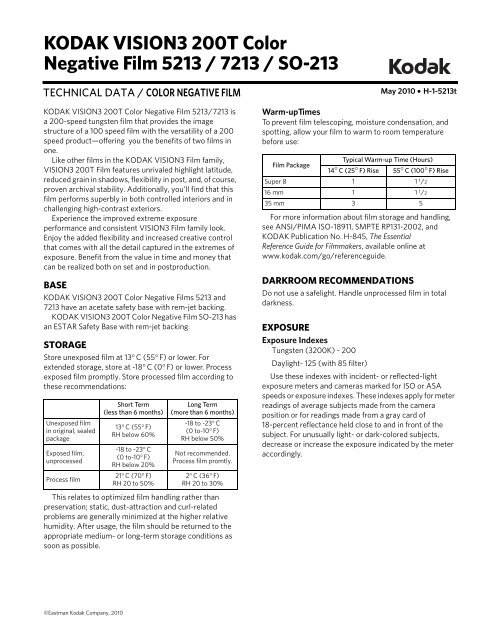
![FUJICHROME ASTIA 100F Professional [RAP100F] - Wittner ...](https://img.yumpu.com/27567144/1/190x253/fujichrome-astia-100f-professional-rap100f-wittner-.jpg?quality=85)
